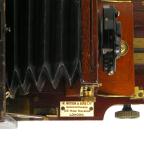Watson Alpha De Luxe Camera
W. Watson & Sons Ltd
| Plate / Film Size: | ¼ plate |
| Lens: | Preminar f4.5, F=105mm (Serial 739706) |
| Shutter: | Compur Compound (Serial 258646) |
| Movements: | Swing front & back; rising front. Reversible back. |
| Dimensions (w x h x l): | |
| Date of this Example: | c1915 |
| Serial Number: | 14582 stamped into leather covering on base |
| Availability: |
|
| Inventory Number: | 646 |
|
Photos copyright © 2016 David Purcell. Do not use without permission. |
Description
The Alpha De Luxe camera is a leather covered box form hand or tripod camera, with a full range of movements provided by a swing back and front, rising front, reversing back. The degree of rise available is significant as not only can the lens panel be raised, but also the whole front standard can rise as this is also mounted in slotted rails. The top face of the camera has a hinged section that can be released to ensure that the camera body does not foul the bellows when the rise is used.
The camera has a baseboard that can drop, and a separate inner rack and pinion focusing section to allow wide angle lenses to be used. According to the advert in the 1911 BJPA, this extra rack and pinion for wide angle use was an optional extra. The teeth on both pinions are cut diagonally.
It has double extension, chamfered section black bellows. There are three focus scales fitted, which are original to the camera, and are marked as 4½, 7¼, 8½ (inches), with two scale pointers on the moving slider, marked "S" and "C", to identify the position to use for the Single and Combination lens options respectively. A single infinity stop is inset into the baseboard.
The makers label is fitted to the baseboard on the opposite side to the three focus scales. The Watson name plate is for 'W. Watson & Sons Limited'.
The camera has fittings for a separate finder on the top face. There is a fitting inside the camera body, mounted to the inside wall, that appears to hold the finder, but all that now remains is the mirror.
This example of the Alpha De Luxe is fitted with a Compur compound shutter and a Preminar lens, which I have not been able to identify. The shutter serial suggests a date of c1914, which could be right for the camera given its serial (14582), but further research required. The lens is not mentioned explicitly in the Lens Vade Mecum [10].
The camera has a stout black hide case, lined with green velvet, and split into two sections to hold the camera and DDS. It has 3 ebonised DDS. The original leather strap is also folded up in the case.
The top of the hide case carries a makers label for 'W. Watson & Sons Ltd', with addresses for a branch at 16 Forrest Road Edinburgh, a depot in 2 Easy Row Birmingham, and optical works in Bell's Hill, Barnet. One source indicates that the Forrest Road address was only used until 1914, although the address is still listed in the 1915 BJPA, but is not shown in the 1916 edition.
Notes
I am engaged in some research into cameras made by W. Watson & Sons in order to try and establish some guidance on likely manufacturing date based upon the serial number. This is in fact quite difficult to do currently as many patterns of Watson cameras were made for very long periods with few significant design changes.
If you have a Watson camera, then I would be grateful if you could provide me with further information about your camera, even if it is not serialised. Please refer to the Watson Research Project page for further information.

![[ ]](../../images/unchecked.png)
![[x]](../../images/checked.png)














